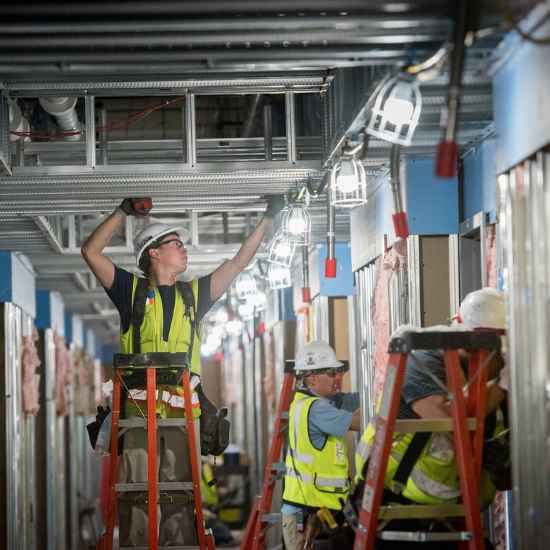Construction Industry Trends: June 2023 Roundup
0%
Construction Worker Safety Market Growth
It’s no secret that construction can be a dangerous industry. Manual labor and heavy lifting make physical injury more likely to happen, and despite efforts to increase job-site safety, bad things still happen sometimes. However, new advances in technology and automation are making construction jobs safer than ever as machines take over some of the more dangerous jobs, thereby reducing the number of on-the-job injuries.
Automation has been a solution for supplementing labor for many industries following the pandemic, but construction was early to adopt automation to supplement an aging workforce. Construction has been working on establishing new talent pipelines while also heavily investing in automation to supplement their workforce. It shows: The Global Construction Worker Safety Market size is expected to reach $5.6 billion by 2029, with nearly 10% in annual growth projected. Perhaps there’s a positive for blue collar workers in the AI revolution after all.

North America: The Leading Region of Growth
According to the same report, North America is one of the regions leading the way in the safety market with more cutting-edge work safety solutions. The Bipartisan Infrastructure Law passed in 2021 also includes funding that specifically addresses enhancing safety standards and buttressing government requirements for safety.
Companies that wish to win government contracts for funding from the Bipartisan Infrastructure Law will need to invest in worker safety. North America accounts for $881.1 million of the global construction worker safety market share.
Other regions experiencing population growth (many in Asia) have experienced increased demand for construction to both expand their municipal footprint and house more people. All of this means that the expectation of continued demand for employment in the construction industry will likely extend to increased demand for construction worker safety equipment as well.
Cost Constraints on the Worker Safety Market
There are significant costs involved in updating construction site safety, from installing and maintaining new state-of-the-art machinery to re-training employees to use the equipment. This is cost-prohibitive for many smaller companies, especially in smaller countries where there aren’t robust levels of government funding going to private enterprise.
Despite the cost, there is a substantial need for workplace safety to guard against a wide range of dangers on the job site, from ergonomic disasters to chemical or biological threats. There is a renewed focus on investing in dependable safety solutions to safeguard a contractor’s greatest asset: their workers.
Decarbonization Momentum & ESG
According to a recent McKinsey & Company report, construction firms are allotting up to 70% of their procurement spend on reaching their sustainability goals. While many private companies are increasing their investments in Environmental, Social, and Corporate Governance (ESG), it can be difficult to truly rate any businesses on factors such as their sustainability—especially in an emissions-heavy industry. But there is evidence that could be changing.
Currently, the construction industry accounts for 25% of global carbon dioxide emissions, but decarbonization initiatives continue to gain momentum. This momentum depends on continued support for the potential for ESG as a strategic opportunity worth investing in, with construction companies looking to appeal to leading developers in the future who will be looking to balance cost and sustainability.
The Potential of Procurement
Sustainability is a factor in cost of procurement—but inefficiency that creates delays is another key factor. Procurement plays an essential role in making cost and sustainability trade-offs by helping determine the most sustainable suppliers to work with and securing sustainably sourced materials or technology—all of which have the added challenge of being in high demand and short supply.
Procurement has the potential to bring together the entire supply chain to work together towards the same sustainability goals, which will be critical in delaying environmental decay and creating long-term investment growth.
The Growing Shift to Electric Equipment
New efforts are in place to retrofit existing vehicles with pure-electric or hybrid engines—an expensive process, but still a cheaper way to update construction equipment than buying new. Earlier this year, Manitou Group successfully retrofitted used diesel telehandlers with electrification kits, but it will still be in testing over the next two years. After testing for technical and economic feasibility, the company has announced plans to extend the electrification kits to other machines in their fleet as early as 2024.
It is feasible for many machines to convert to electric, especially hydraulic machines. There is potential to apply the same electrification method to most types of equipment by simply removing the engine and pump to replace them with parts that are compatible with electric components. Many machines are already diesel-electric hybrids where the engine acts only as an initial generator, but the main driving force is electric which makes the conversion of such vehicles that much easier.

Unfortunately, new regulations in Europe might not be compatible with retrofit electrification. There are plans to implement a battery passport which will be a part of a digital record system that tracks electric vehicles in the EU market with a capacity of over 2kWh. This will require data from a complicated web of involved parties, from the battery producers to automotive OEMs and repurposing companies.
The Airport Construction Trend
Airlines are in the news again for canceling another wave of flights over the weekend as they have struggled to staff airports to keep up with the spike in demand for air travel ever since the pandemic. Some airports are using this opportunity to expand. The market for airport construction around the globe increased to an estimated $1.3 trillion last year and is expected to reach $1.8 trillion by 2030 with a CAGR of 4.3%.
The U.S. market comprises $123.9 billion of that, while China is expected to reach a market size of $201.6 billion by 2030. Japan and Canada are also expected to grow at 2.7% during the same period while Germany is forecast to grow by 2.6% CAGR. The Asia-Pacific region led by India, Australia, and South Korea is projected to reach $535.8 billion by 2030 as well.






